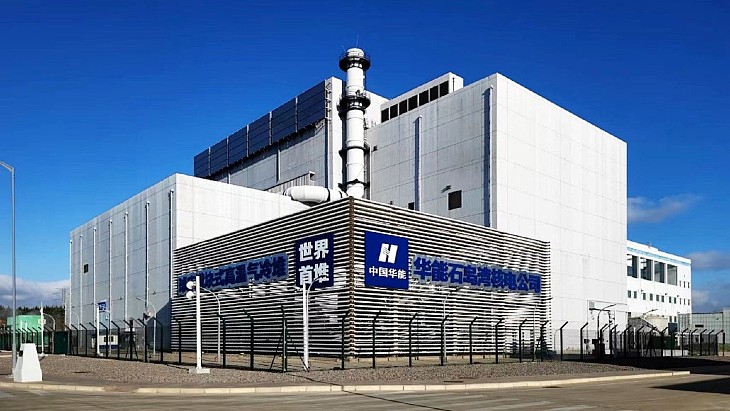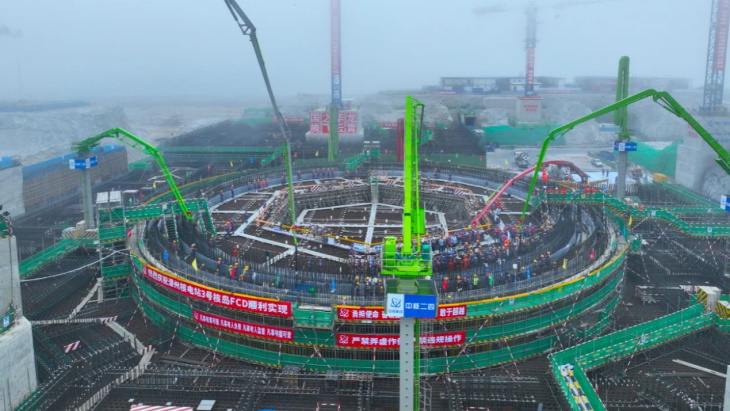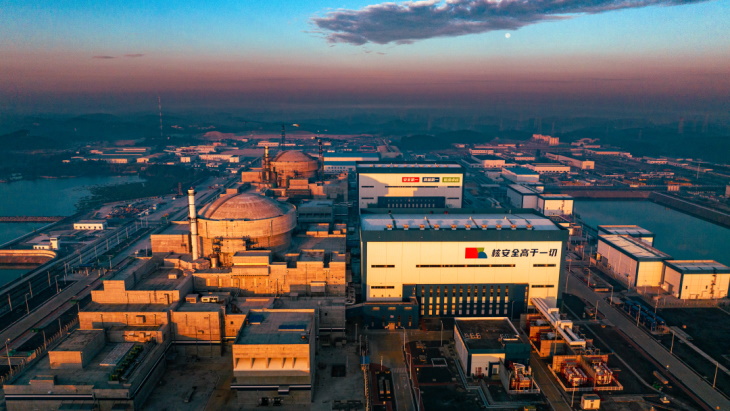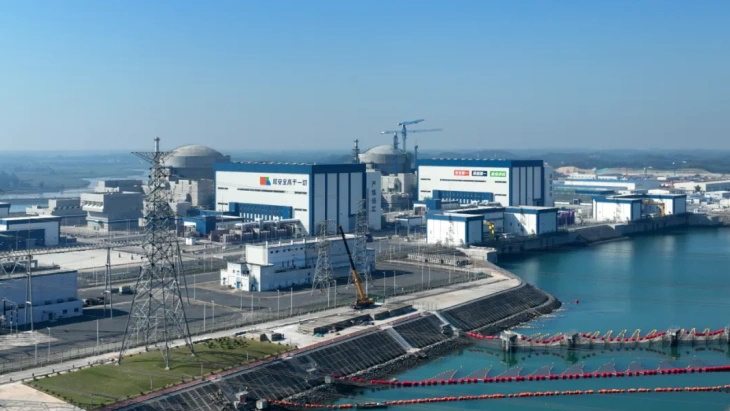https://www.world-nuclear-news.org/Arti ... -operationChina's demonstration HTR-PM enters commercial operation
06 December 2023
The world’s first modular high temperature gas-cooled reactor nuclear power plant has entered commercial operation, China’s National Energy Administration has announced.
The nuclear island of HTR-PM Demo (Image: Tsinghua University)
It follows a successful 168-hour demonstration run for the High Temperature Gas-Cooled Reactor - Pebble-bed Module (HTR-PM) in Shidao Bay (also known as Shidaowan), in Shandong Province, which is currently operating at 2×200 MWt power.
The HTR-PM features two small reactors (each of 250 MWt) that drive a single 210 MWe steam turbine. It uses helium as coolant and graphite as the moderator. Each reactor is loaded with more than 400,000 spherical fuel elements (‘pebbles’), each 60 mm in diameter and containing 7 g of fuel enriched to 8.5%. Each pebble has an outer layer of graphite and contains some 12,000 four-layer ceramic-coated fuel particles dispersed in a graphite matrix. The fuel has high inherent safety characteristics, and has been shown to remain intact and to continue to contain radioactivity at temperatures up to 1620°C - far higher than the temperatures that would be encountered even in extreme accident situations, according to the China Nuclear Energy Association.
First concrete for the demonstration project was poured on December 2012, with the operating permit granted in August 2021 and the plant connected to the grid in December 2021. The plant has more than 2200 sets of first-of-a-kind equipment, including more than 660 sets of innovative equipment. The supporting fuel element production line has the largest production capacity in the world.
The project is a collaborative effort involving Tsinghua University as a technical leader, responsible for research and development and main components and systems design, with China Huaneng Group as the owner and operator of the plant, and China National Nuclear Coorporation as the engineering, procurement, and construction contractor and fuel manufacturer. Professor Zuoyi Zhang, director of the Institute of Nuclear and New Energy Technology at Tsinghua University, is the chief scientist and chief engineer for the project.
HTR-PM is a Generation IV nuclear energy technology and a small modular reactor. Two safety demonstration tests were conducted on the reactor modules, each at a power of 200 MWt, on 13 August and 1 September, respectively.
A Tsinghua spokesperson said: "The normal energy transfer driven by power was stopped during the tests. The measured nuclear power and temperatures within the different reactor structures, described how the reactors were naturally cooled down, without intervention of humans or emergency core cooling systems. The tests confirmed that commercial-scale reactors could be cooled down naturally without emergency core cooling systems for the first time in the world. It is the so-called inherently safe reactor.
"The major purpose of HTR-PM is to co-generate high temperature steam up to 500℃ and electricity. It is cost effective currently in the Chinese market to supply steam and electricity for the petrochemical industry to substitute the burning of natural gas and coal. This breakthrough technology is recognised to play a positive role in optimising energy structure and achieving China's 'dual carbon' goal. Several commercial projects are under preparation in China."
China's National Energy Administration, in announcing the start of commercial operation, said: "The commissioning of the demonstration project is of great significance and has a positive impact on promoting the safe development of nuclear power in our country and improving our country's nuclear power power scientific and technological innovation capabilities."
In an interview last year for World Nuclear Association's World Nuclear Performance Report 2022, Lu Hua Quan, chairman of the Nuclear Research Institute, Huaneng Company, explained: "HTRs have the highest operating temperatures of all existing reactor types, and are also the only reactors that can provide very high-temperature process heat." He said there was export potential, especially to countries and regions where freshwater resources were scarce, adding that "HTRs could in the future provide a source of high-quality high-temperature process heat for various industries, in particular those that are required to limit their carbon emissions".
The HTR-PM follows on from China's HTR-10, a 10 MWt high-temperature gas-cooled experimental reactor at Tsinghua University's Institute of Nuclear and New Energy Technology, which started up in 2000 and reached full power in 2003. Beyond the HTR-PM, China proposes a scaled-up version - HTR-PM600 - with one turbine rated at 650 MWe driven by six reactor modules.
Le nucléaire en Chine
Modérateurs : Rod, Modérateurs
- energy_isere
- Modérateur

- Messages : 90152
- Inscription : 24 avr. 2005, 21:26
- Localisation : Les JO de 68, c'était la
- Contact :
Re: Le nucléaire en Chine
suite du post au dessus. C'est donc un Pebble-bed Module reactor
- energy_isere
- Modérateur

- Messages : 90152
- Inscription : 24 avr. 2005, 21:26
- Localisation : Les JO de 68, c'était la
- Contact :
Re: Le nucléaire en Chine
voir l' entrée Wikipedia pour ce type de réacteur. https://fr.wikipedia.org/wiki/HTR-PM
et
et
https://www.nextbigfuture.com/2023/12/c ... ation.htmlChina’s Pebble Bed Reactor Finally Starts Commercial Operation
December 13, 2023 by Brian Wang
......................

- energy_isere
- Modérateur

- Messages : 90152
- Inscription : 24 avr. 2005, 21:26
- Localisation : Les JO de 68, c'était la
- Contact :
Re: Le nucléaire en Chine
lire https://www.revolution-energetique.com/ ... ometteuse/Nucléaire : voici le réacteur à « lit de boulets », une technologie hyper prometteuse
Un second réacteur modulaire avancé (AMR en anglais) de 4ᵉ génération refroidi par hélium a été mis en service en Chine. C’est une grande avancée technologique pour ce type de réacteur à haute température (HT), domaine dans lequel l’Allemagne était jadis pionnière. Il utilise la technologie à « lit de boulets », censée apporter sûreté, modularité et permettrait, au-delà de la production électrique, de fournir de la vapeur industrielle et du chauffage urbain bas-carbone. Mais comment fonctionne-t-elle ?
18 Déc 2023 Ugo PETRUZZI
..............................

- GillesH38
- Hydrogène

- Messages : 27390
- Inscription : 10 sept. 2005, 17:07
- Localisation : Berceau de la Houille Blanche !
- Contact :
Re: Le nucléaire en Chine
de l'hélium liquide à 700 °C ? euh, il a du y avoir une confusion quelque part ....De symbole chimique He, l’hélium est un gaz dont les propriétés satisfaisantes de conduction et transfert de chaleur représentent un avantage : il n’interfère que peu avec les neutrons. C’est une qualité, car le fluide circule directement dans le cœur là où la réaction se produit. Grâce à sa propriété non métallique, il pourra monter plus haut en température : jusqu’à 700 °C lui sont imposés dans le cœur. À ce palier haut, il reste liquide sans changer de phase.
Zan, zendegi, azadi. Il parait que " je propage la haine du Hamas".
- energy_isere
- Modérateur

- Messages : 90152
- Inscription : 24 avr. 2005, 21:26
- Localisation : Les JO de 68, c'était la
- Contact :
Re: Le nucléaire en Chine
oui ca m'a choqué aussi de la part du rédacteur. C'est pas pour rien que ça s'appelle ''High Temperature Gas-Cooled Reactor''GillesH38 a écrit : ↑19 déc. 2023, 10:44de l'hélium liquide à 700 °C ? euh, il a du y avoir une confusion quelque part ....De symbole chimique He, l’hélium est un gaz dont les propriétés satisfaisantes de conduction et transfert de chaleur représentent un avantage : il n’interfère que peu avec les neutrons. C’est une qualité, car le fluide circule directement dans le cœur là où la réaction se produit. Grâce à sa propriété non métallique, il pourra monter plus haut en température : jusqu’à 700 °C lui sont imposés dans le cœur. À ce palier haut, il reste liquide sans changer de phase.
- energy_isere
- Modérateur

- Messages : 90152
- Inscription : 24 avr. 2005, 21:26
- Localisation : Les JO de 68, c'était la
- Contact :
Re: Le nucléaire en Chine
https://www.world-nuclear-news.org/Arti ... w-reactorsChina approves construction of four new reactors
03 January 2024
The construction of two Hualong One reactors at each of the Taipingling and Jinqimen sites was approved by China's State Council at a 29 December meeting. Meanwhile, various milestones have been reached in the construction of other Chinese units.
At the meeting of the Standing Committee of the State Council, chaired by Chinese Premier Li Qiang, approval was granted for units 3 and 4 at China General Nuclear's (CGN's) existing Taipingling nuclear power plant in Guangdong province, as well as units 1 and 2 at China National Nuclear Corporation's (CNNC's) new Jinqimen nuclear power plant in Zhejiang province.
The Taipingling plant will eventually have six Hualong One reactors. The construction of the first and second units began in 2019 and 2020, respectively. Unit 1 is scheduled to start up in 2025, with unit 2 following in 2026.
..................
- energy_isere
- Modérateur

- Messages : 90152
- Inscription : 24 avr. 2005, 21:26
- Localisation : Les JO de 68, c'était la
- Contact :
Re: Le nucléaire en Chine
suite de ce post du 17 sept 2022 http://www.oleocene.org/phpBB3/viewtopi ... 6#p2352766
https://www.world-nuclear-news.org/Arti ... hangzhou-pConstruction starts on second phase of Zhangzhou plant
22 February 2024
The first safety-related concrete has been poured for the nuclear island of unit 3 at the Zhangzhou nuclear power plant in Fujian province, China National Nuclear Corporation (CNNC) announced. It is the first of two Hualong One units planned as the second phase of the plant, which will eventually house six such reactors.
The first concrete is poured for the basemat of Zhangzhou unit 3 (Image: CNNC)
In May 2014, the local government gave approval for Phase I of the Zhangzhou plant, comprising two AP1000 units. The National Nuclear Safety Administration gave approval in December 2015 for the AP1000 units and confirmed site selection in October 2016. Construction of Phase I had originally been expected to start in May 2017. However, CNNC subsequently decided to use the HPR1000 (Hualong One) design instead. Two more Hualong One units are planned for Phase II of the plant and a further two proposed for Phase III.
Construction of Zhangzhou 1 began in October 2019, with that of unit 2 starting in September 2020. The units are scheduled to enter commercial operation in 2024 and 2025, respectively.
CNNC issued the environmental impact assessment for Zhangzhou units 3 and 4 in October 2020. In September 2022, China's State Council approved the construction of two Hualong One units as Phase II of the Zhangzhou plant.
CNNC has now announced that work on Phase II has commenced, with the pouring of first concrete for the nuclear island of unit 3 on 22 February.
The Zhangzhou project is owned by CNNC-Guodian Zhangzhou Energy Company, a joint venture between CNNC (51%) and China Guodian Corporation (49%).
The first two demonstration units of CNNC's version of the Hualong One design at the Fuqing plant in Fujian province have both already started up. Unit 5 entered commercial operation on 30 January 2021, with unit 6 following on 25 March 2022. Two Hualong One reactors have also been constructed as units 2 and 3 of the Karachi plant in Pakistan's Sindh province. These entered commercial operation in May 2021 and April 2022, respectively.
"At present, the first four units of Hualong One have been completed and put into operation, and the batch construction is progressing smoothly," CNNC said. "Among them, the Zhangzhou Nuclear Power Project is the starting point for the batch construction of Hualong One: unit 1 is expected to be put into operation in 2024; unit 2 is undergoing cold test-related preparations such as the installation of internal components of the reactor."
In addition to Zhangzhou units 1-3, CNNC is also building two Hualong One reactors as units 3 and 4 of the Changjiang plant, in Hainan province, construction of which began in March 2021 and December 2021, respectively.
Earlier this week, it also held a ground-breaking ceremony for Phase I of the Jinqimen plant in Zhejiang province, which will also feature two Hualong One reactors.
- energy_isere
- Modérateur

- Messages : 90152
- Inscription : 24 avr. 2005, 21:26
- Localisation : Les JO de 68, c'était la
- Contact :
Re: Le nucléaire en Chine
suite de ce post du 13 janvier 2023 http://www.oleocene.org/phpBB3/viewtopi ... 9#p2360889
aprés Fangchenggang 3 , Fangchenggang 4 :
aprés Fangchenggang 3 , Fangchenggang 4 :
https://www.world-nuclear-news.org/Arti ... ng-licenceFangchenggang 4 receives operating licence
28 February 2024
China's National Nuclear Safety Administration has granted an operating licence for unit 4 of the Fangchenggang nuclear power plant in China's Guangxi Autonomous Region. The unit is the second of two demonstration China General Nuclear-designed Hualong One (HPR1000) reactors at the site.
Fangchenggang units 3 and 4 (Image: CGN)
Obtaining the licence is "an important step towards high-quality production and commercial operation", China General Nuclear (CGN) said, adding that the loading of fuel into the 1180 MWe (gross) pressurised water reactor's core "is about to start".
First concrete was poured for the nuclear island of unit 3 - 39% owned by Guangxi Investment Group and 61% by CGN - in December 2015, while that for unit 4 was poured a year later. Unit 3 was originally expected to start up in 2019, with unit 4 scheduled to start up in 2020. Both their start-ups were subsequently postponed until 2022.
In January 2022, CGN announced that the start-up of Fangchenggang 3 and 4 had been put back again due to delays caused by the COVID-19 pandemic. Unit 3 achieved first criticality - a sustained chain reaction - on 27 December 2022 and was synchronised with the grid on 10 January 2023. It entered commercial operation on 25 March.
Hot functional testing of unit 4 began on 25 September last year. These tests involve increasing the temperature of the reactor coolant system and carrying out comprehensive tests to ensure that coolant circuits and safety systems are operating as they should. Carried out before the loading of nuclear fuel, such testing simulates the thermal working conditions of the power plant and verifies that nuclear island and conventional equipment and systems meet design requirements.
CGN has confirmed that unit 4 is expected to be put into operation in the first half of this year.
The Fangchenggang plant is planned to house six reactors. The first phase comprises two CPR-1000 units which were put into commercial operation in 2016.
The first two units of China National Nuclear Corporation's version of the Hualong One design at the Fuqing plant in Fujian province have both already started up. Unit 5 entered commercial operation on 30 January 2021, with unit 6 following on 25 March 2022.
- energy_isere
- Modérateur

- Messages : 90152
- Inscription : 24 avr. 2005, 21:26
- Localisation : Les JO de 68, c'était la
- Contact :
Re: Le nucléaire en Chine
https://www.world-nuclear-news.org/Arti ... ying-powerNew Chinese reactor begins supplying power
11 April 2024
Fangchenggang unit 4 - the second demonstration Hualong One (HPR1000) reactor at the site in China's Guangxi Autonomous Region - has been connected to the grid, China General Nuclear (CGN) announced.
The company said the 1180 MWe (gross) pressurised water reactor was successfully connected to the grid at 8.29pm on 9 April, "marking that the unit has the power generation capability and has taken another key step towards the goal of commercial operation".
CGN noted that a series of subsequent tests will be carried out to further verify the various performances of the unit with commercial operating conditions. It said the reactor is expected to be put into "high-quality production" in the first half of this year.
First concrete was poured for the nuclear island of Fangchenggang unit 3 - 39% owned by Guangxi Investment Group and 61% by CGN - in December 2015, while that for unit 4 was poured a year later. Unit 3 was originally expected to start up in 2019, with unit 4 scheduled to start up in 2020. Both their start-ups were subsequently postponed until 2022.
However, in January 2022, CGN announced that the start-up of Fangchenggang 3 and 4 had been put back again due to delays caused by the COVID-19 pandemic. Unit 3 achieved first criticality - a sustained chain reaction - on 27 December 2022 and was synchronised with the grid on 10 January 2023. It entered commercial operation on 25 March.
China's National Nuclear Safety Administration (NNSA) granted CGN an operating licence for Fangchenggang 4 on 27 February, allowing the loading of fuel into the reactor's core to begin. The fuel loading process was completed on 2 March. The reactor reached first criticality on 3 April.
The Fangchenggang plant is planned to house six reactors. The first phase comprises two CPR-1000 units which were put into commercial operation in 2016. Units 5 and 6 are expected to feature Hualong One reactors.
The first two units of China National Nuclear Corporation's version of the Hualong One design at the Fuqing plant in Fujian province have both already started up. Unit 5 entered commercial operation on 30 January 2021, with unit 6 following on 25 March 2022.
- energy_isere
- Modérateur

- Messages : 90152
- Inscription : 24 avr. 2005, 21:26
- Localisation : Les JO de 68, c'était la
- Contact :
Re: Le nucléaire en Chine
suite de ce post du 8 novembre 2023 http://www.oleocene.org/phpBB3/viewtopi ... 3#p2379783
https://www.world-nuclear-news.org/Arti ... ns-at-ChinDigital control system installation begins at Chinese SMR
11 April 2024
Installation of the digital control system has begun at the ACP100 small modular reactor demonstration project at the Changjiang site on China's island province of Hainan, China National Nuclear Corporation (CNNC) has announced.
............................
CNNC announced in July 2019 the launch of a project to construct an ACP100 reactor at Changjiang. The site is already home to two operating CNP600 pressurised water reactors (PWRs), while the construction of the two Hualong One units began in March and December 2021. Both those units are due to enter commercial operation by the end of 2026.
First concrete for the ACP100 was poured on 13 July 2021, with a planned total construction period of 58 months. Equipment installation work commenced in December 2022 and the main internal structure of the reactor building was completed in March 2023.
Under development since 2010, the 125 MWe ACP100 integrated PWR's preliminary design was completed in 2014. In 2016, the design became the first SMR to pass a safety review by the International Atomic Energy Agency.
Once completed, the Changjiang ACP100 reactor will be capable of producing 1 billion kilowatt-hours of electricity annually, enough to meet the needs of 526,000 households. The reactor is designed for electricity production, heating, steam production or seawater desalination.
The project at Changjiang involves a joint venture of three main companies: CNNC subsidiary China National Nuclear Power as owner and operator; the Nuclear Power Institute of China as the reactor designer; and China Nuclear Power Engineering Group being responsible for plant construction.



